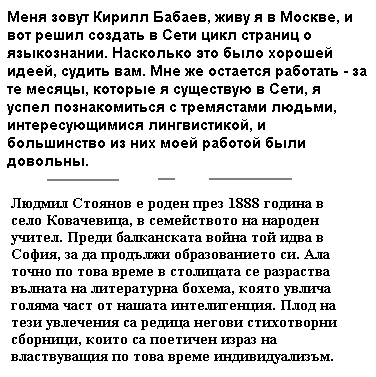- History and Description
- Images
- Sample text
- More information
Many symbols of the alphabet were added in vain, for there were no sounds for them in Slavic; such letters are w, q, s, i and some others, later extinct. The Old Church Slavic language, the first which used Cyrillic, also introduced many diacritics to it: stress markers, aspiration markers etc., though there were no aspiration at all in Slavic. Besides, many signs for nasal vowels were invented for Slavic languages.
In the 10th and 11th centuries Cyrillic was in wide use in all countries populated by those Slavs who accepted Christianity - Bulgaria, Croatia, Serbia, Moravia. After 988, when Kiev Russia also took up Christianity, Cyrillic becomes the first Russian alphabet. The oldest texts and inscriptions in Cyrillic date from the 10th century (Bulgaria), from the 11st century (Russia), and from the 12th century (Bosnia and Serbia). Gradually the number of letters, the shape of them and sometimes the pronunciation changed a little, together with changes in languages. The only language which preserves Cyrillic in its initial form is Old Church Slavic, the language for Orthodox cults in several East European countries. The weakening influence of the Byzantine Empire gave way to Roman letters to replace Cyrillic in Europe: since the 16th century Czech and Polish kingdoms and the Lithuanian principality take up the Roman alphabet, in the 17th century the same happens in Romania. But in temples of those countries Cyrillic was used for two more centuries.
Nowadays Cyrillic is used in Russia, Bulgaria, Yugoslavia, Macedonia, Bosnia, Belorussia, Ukraine. Many alphabets of Asiatic nations are also based on Cyrillic, for it is much easier to learn than Arabic or Chinese. Therefore Kazakhstan, Uzbekistan, Kirghizia, and Mongolia write in Cyrillic letters; earlier it was also in use in Azerbaijan, Tadjikistan and Turkmenistan.
Languages which use the script: Slavic
(Old Church Slavic, Russian, Serbo-Croatian, Bulgarian, Ukrainian, Belorussian,
Macedonian), Iranian (Ossetic, Tati),
non-Indo-European (Kazakh, Uzbek, Kirghiz, Mongolian, hundreds of languages
of Russia).
Images:
- Alphabets (genealogical chart)
- Old Church Slavic Cyrillic
- Modern Russian Cyrillic
- Modern Montenegrin Cyrillic
- Cyrillic Inscription of the 12th century (Bulgaria)
Sample text (Russian & Bulgarian):

Menya zovut Kirill Babajev, zhivu ja v Moskve, i vot reshil sozdat' v Seti tsikl statej o jazykoznanii. Naskol'ko eto bylo khoroshej idejej, sudit' vam. Mne zhe ostajots'a rabotat' - za te mes'atsy, kotoryje ja sushchestvuju v Seti, ja uspel poznakomit's'a s trem'astami l'ud'mi, interesujushchimis'a lingvistikoj, i bol'shinstvo iz nikh byli mojej rabotoj dovol'ny.
L'udmil Stojanov je roden prez 1888 godina v selo Kovachevitsa, v semejstvoto na naroden uchitel. Predi balkanskata vojna toj idva v Sofija, za da produlzhi obrazovanijeto si. Ala tochno po tova vreme v stolitsata se razrastva vulnata na literaturna bokhema, kojato uvlicha gol'ama chast ot nashata inteligentsija. Plod na tezi uvlechenija sa reditsa negovi stikhotvorni sbornitsy, koito sa poetichen izraz na vlastvuvashchija po tova vreme individualizum.
My name is Cyril Babaev, I live in Moscow, and here I decided to create pages in the Net about linguistics. Whether it was a good idea, it's up yo you to judge. What I have to do is to work - during those months while I exist in the Net, I had a chance to get acquainted with three hundred people who are interested in linguistics, and the majority of them were content with my work.
Lyudmil Stoyanov was born in 1888 in the village of Kovachevitsa, in
the family of the people's teacher. Before the Balkan War they moved to
Sofia, where he continued his education. And just by that time in the capital
a new wave of literature style was rising, which attracted attention of
the most part of our intellectuals. The fruit from such his passions were
his collected poems, the image of which is the individualism which dominated
at the time.
More information: